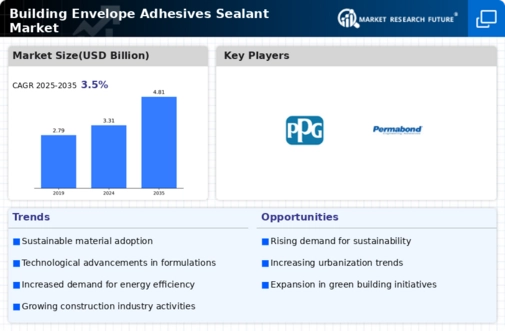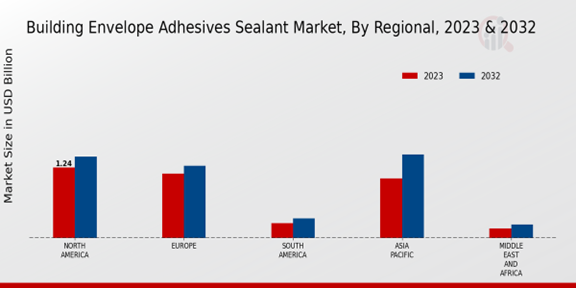Market Growth Projections
The Global Building Envelope Adhesives Sealant Market Industry is projected to experience substantial growth over the next decade. With an estimated market value of 3.31 USD Billion in 2024, the industry is expected to reach 4.81 USD Billion by 2035, reflecting a CAGR of 3.46% from 2025 to 2035. This growth is indicative of the increasing demand for advanced sealing solutions across various construction sectors. Factors such as urbanization, technological advancements, and regulatory pressures are likely to contribute to this upward trend, positioning the market for continued expansion in the coming years.
Energy Efficiency Regulations
Energy efficiency regulations are increasingly influencing the Global Building Envelope Adhesives Sealant Market Industry. Governments are implementing stringent standards aimed at reducing energy consumption in buildings, which necessitates the use of high-performance sealants. These regulations often require the integration of advanced sealing solutions to enhance thermal performance and minimize air leakage. As a result, manufacturers are focusing on developing products that comply with these regulations, thereby driving market growth. The ongoing push for energy-efficient buildings is likely to create a sustained demand for innovative adhesive solutions that meet regulatory requirements.
Sustainable Construction Practices
The increasing emphasis on sustainable construction practices drives the Global Building Envelope Adhesives Sealant Market Industry. As regulations tighten around environmental impact, builders are seeking eco-friendly adhesives and sealants that minimize carbon footprints. For instance, products with low volatile organic compounds (VOCs) are gaining traction. This shift is reflected in the projected market growth, with the Global Building Envelope Adhesives Sealant Market expected to reach 3.31 USD Billion in 2024. The demand for sustainable materials is likely to enhance the market's value as more construction projects prioritize green building certifications.
Urbanization and Infrastructure Development
Urbanization and infrastructure development are key drivers of the Global Building Envelope Adhesives Sealant Market Industry. Rapid urban growth necessitates the construction of residential and commercial buildings, which in turn increases the demand for effective sealing solutions. Governments worldwide are investing in infrastructure projects, further propelling market growth. For example, in regions experiencing significant urban expansion, the need for reliable building envelope systems becomes critical. This trend is expected to sustain the market's upward trajectory, as more projects require advanced adhesive technologies to ensure structural integrity and energy efficiency.
Rising Demand for Prefabricated Construction
The rising demand for prefabricated construction is reshaping the Global Building Envelope Adhesives Sealant Market Industry. Prefabrication allows for faster construction timelines and improved quality control, necessitating specialized adhesives and sealants that can bond various materials effectively. This trend is particularly evident in modular construction, where components are manufactured off-site and assembled on-site. As the market adapts to this shift, the demand for high-performance sealants that ensure durability and weather resistance is expected to grow. This evolution in construction methods could significantly impact the adhesive market, driving innovation and product development.
Technological Advancements in Adhesive Formulations
Technological advancements in adhesive formulations are pivotal for the Global Building Envelope Adhesives Sealant Market Industry. Innovations such as hybrid adhesives, which combine the properties of different materials, enhance performance and application versatility. These advancements lead to improved adhesion, flexibility, and durability, catering to diverse building materials. As a result, the market is anticipated to grow at a CAGR of 3.46% from 2025 to 2035, reaching an estimated 4.81 USD Billion by 2035. This trend indicates a strong inclination towards high-performance sealants that can withstand varying environmental conditions.














Leave a Comment